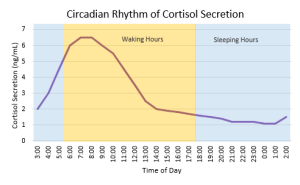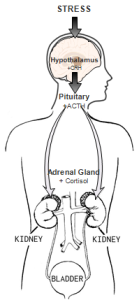Original Article For White Lotus Clinic HERE
Today you will learn
- Your adrenal glands are not ‘burnt out’.
- Your brain is at the root of your issues.
- How to properly test adrenal function.
Adrenal fatigue is a term that has been used in the Naturopathic community for many years to describe symptoms of debilitating fatigue, abnormal sleep patterns, strong responses to stress, weight gain around the middle etc (See below for more information). The truth is though, the term ‘adrenal fatigue’ is an oversimplified model. Your adrenals are only a small part of a signaling system in your body associated with moderating and responding to stress, changes in our environment etc. These adrenals are in direct communication with the hypothalamus and pituitary, through what’s called the hypothalamus-pituitary-adrenal axis.
 The adrenals are a set of small glands that sit on top of your kidneys. These tiny glands are critical to our survival as they produce hormones such as progesterone, estrogen, testosterone, DHEA, cortisol, aldosterone, epinephrine and norepinephrine. When this system is working properly the Hypothalamus in our brain will release a hormone called Corticotrophin Releasing Hormone (CRH) in response to a stressor (like a bear, or your boss). Then this signals the pituitary to make adrenocorticotropin hormone (ACTH) which stimulates our bodies to make cortisol. Cortisol will then communicate back to the brain that enough has been made and the system shuts off. This system is critical and keeps us alive. But it is meant to be triggered at most once to twice per day, not once to twice per hour!
The adrenals are a set of small glands that sit on top of your kidneys. These tiny glands are critical to our survival as they produce hormones such as progesterone, estrogen, testosterone, DHEA, cortisol, aldosterone, epinephrine and norepinephrine. When this system is working properly the Hypothalamus in our brain will release a hormone called Corticotrophin Releasing Hormone (CRH) in response to a stressor (like a bear, or your boss). Then this signals the pituitary to make adrenocorticotropin hormone (ACTH) which stimulates our bodies to make cortisol. Cortisol will then communicate back to the brain that enough has been made and the system shuts off. This system is critical and keeps us alive. But it is meant to be triggered at most once to twice per day, not once to twice per hour!
When this axis starts to malfunction, due to chronic over stimulation, we have what I prefer to call HPA axis dysregulation. This term covers all matter of sins including; high cortisol, low cortisol, altered cortisol rhythms, CRH resistance, ACTH resistance, altered CRH/ACTH release, epinephrine and norepinephrine deficiency, and many more! Although the causes can seem overwhelming what is important is that you know the symptoms and can ask a medical professional for help!
What are the most characteristic signs of HPA axis issues?
- Morning fatigue and unrefreshing sleep
- Feeling ‘wired but tired’ at night or waking at 2-4am wide awake
- A typical pattern of energy swings, feeling fatigued mid morning and mid afternoon while getting a burst of energy around dinner time and after 11pm (your ‘second wind’)
- Lack of productivity
- Brain fog
- Weakness, muscle loss or difficulty gaining muscle
- Fat gain around the middle
- Tendency towards being ‘hangry’
- Feeling dizzy upon standing
- Increases in allergies and sensitivities
- PMS
- Menstrual irregularities
- Low sex drive
- Chronic disease almost always triggers the HPA axis as well
Testing for HPA Axis Issues
When treating HPA axis issues it is important for your doctor to understand not only what your cortisol levels are at different point in the day, because cortisol has a rhythm (see below), but also to look into other hormones. Thyroid disease and chronic infections can also look like adrenal issues. It is important to be tested for this if necessary as well!

4 Point Cortisol
Cortisol levels fluctuate throughout the day, starting to rise at 4am to wake us, and falling at night to allow melatonin, our sleep hormone, to rise. It is important to test cortisol in your saliva upon waking, at lunch, late afternoon and before bed in order to detect abnormal changes in cortisol levels which could be causing your symptoms1.
DHEA-S
DHEA-S is an androgenic hormone that is only produced by the adrenal gland2. This hormone is important to investigate because it can not only tell us about adrenal function but it can also be associated with symptoms such as acne in high levels and fertility concerns3.
Orthostatic hypotension is a test to see if your body can respond quickly enough to a stress, in this case going from lying down to standing up. If you often feel light headed upon standing this could potentially be a sign that your HPA axis is struggling.
 What Causes Adrenal Dysregulation?
What Causes Adrenal Dysregulation?
Stress– Whether it is physical stress, mental stress or perceived stress, our body responds the exact same way. That’s right, running from a bear, watching the news, yelling at the driver beside you – in all of these situations your body increases your cortisol, increases your stress hormones and floods your tissues with blood sugar (and later insulin – storing that sugar away in your fat cells). In the long term these ‘micro stresses’ can do a lot to fatigue your body.
Over exercise– Running on the treadmill for hours per week? Your body thinks you are running from a bear! Too much exercise, especially prolonged cardio, can lead to increased levels of cortisol production. In the short term this can be a great boost, but in the long term it can cause your body to wear down.
Eating patterns– Blood sugar, cortisol and insulin are intricately related! When you think about it, cortisol is a stress hormone that was made to allow humans to run from lions and tigers and bears. When we are running we need access to increased blood glucose, therefore cortisol can trigger the release of sugar into the blood stream. Conversely, low blood sugar is a huge stress to the body, our brains need glucose to survive. When our blood sugar drops too low this immediately triggers a cortisol release. This is exhausting to the body. This is why it is critical that we eat regular meals that are balanced in protein: fat: carbohydrates.
Inflammation – This is a chicken or the egg situation. Cortisol is a potent anti inflammatory hormone, therefore if it isn’t circulation at proper concentrations inflammation can get out of whack. At the same time though, inflammation can trigger cortisol release.
Infection– Fighting an infection is a challenge to the body, and this raises cortisol. Prolonged or chronic infections such as Epstein Bar Virus (mono), lyme disease, herpes virus, HIV etc can cause HPA axis dysregulation and feelings of chronic fatigue, malaise and a feeling of ‘fighting something off’. Additionally, if you have an infection in your gut, such as small intestinal bacterial overgrowth, parasites or simply having more bad bacteria than good bacteria can also result in a stress response in the body!
 So after reading this, you are probably wondering, NOW What?!
So after reading this, you are probably wondering, NOW What?!
Stress seems to be an integral part of the modern culture but we don’t have to deal with the negative side effects! In part two is this article we will discuss many of the treatments to be considered if you identify with HPA axis dysregulation.
References
- Dijk D-J, Duffy JF, Silva EJ, Shanahan TL, Boivin DB, Czeisler CA. Amplitude reduction and phase shifts of melatonin, cortisol and other circadian rhythms after a gradual advance of sleep and light exposure in humans. PLoS One. 2012;7(2):e30037. doi:10.1371/journal.pone.0030037.
- Abdel-Rahman M. Androgen Excess. MedScape. http://emedicine.medscape.com/article/273153-overview. Published 2015.
- Chen M-J, Chen C-D, Yang J-H, et al. High serum dehydroepiandrosterone sulfate is associated with phenotypic acne and a reduced risk of abdominal obesity in women with polycystic ovary syndrome. Hum Reprod. 2011;26(1):227-234. doi:10.1093/humrep/deq308.





